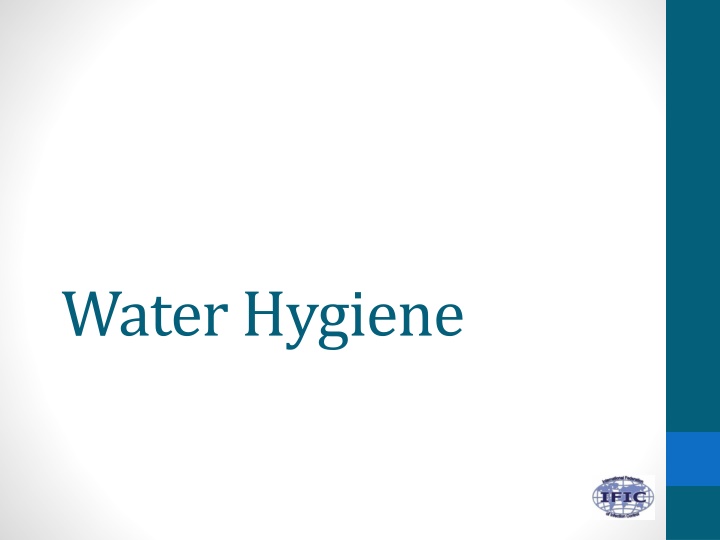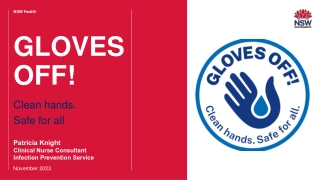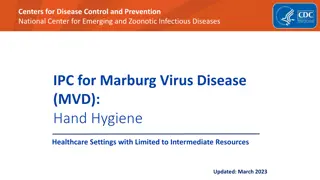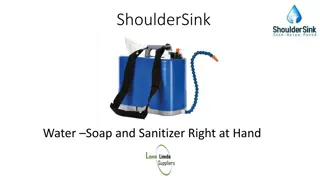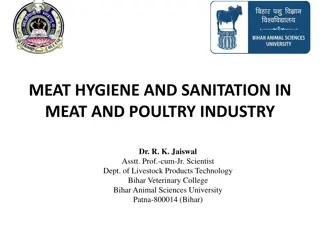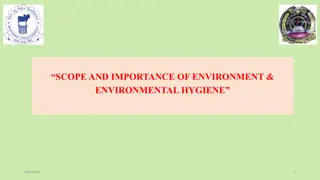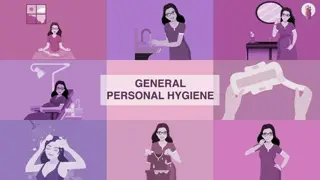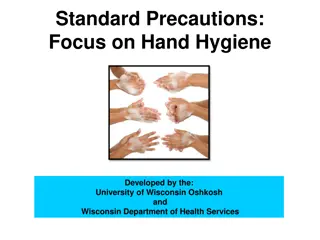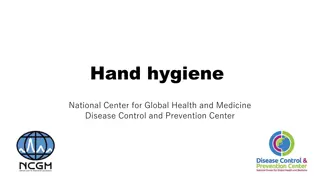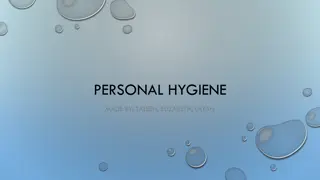Water Hygiene and its Health Implications
Proper water hygiene is crucial in preventing the spread of water-borne diseases like cholera, typhoid, and hepatitis. Regular testing and treatment methods such as boiling or chlorination help ensure safe water for healthcare settings. Insufficient water quality can lead to various illnesses, emphasizing the importance of maintaining clean water sources.
Uploaded on Sep 06, 2024 | 0 Views
Download Presentation

Please find below an Image/Link to download the presentation.
The content on the website is provided AS IS for your information and personal use only. It may not be sold, licensed, or shared on other websites without obtaining consent from the author.If you encounter any issues during the download, it is possible that the publisher has removed the file from their server.
You are allowed to download the files provided on this website for personal or commercial use, subject to the condition that they are used lawfully. All files are the property of their respective owners.
The content on the website is provided AS IS for your information and personal use only. It may not be sold, licensed, or shared on other websites without obtaining consent from the author.
E N D
Presentation Transcript
Learning objectives December 1, 2013 1. Describe the role of infection prevention and control in water hygiene. 2. Identify different methods to make water safe for health care use. 3. Explain the importance of the safe water in infection prevention and control. 2
Time involved December 1, 2013 40 minutes 3
Key Points Protect water sources Piped water quality should be regularly verified Analyses at point of use should be regularly performed Potable water can be rendered microbiologically safe by boiling, filtering, or chlorination In health care settings, additional water treatment may be necessary e.g., deionisation Prevent infectious risks from bacterial contamination and formation of biofilms December 1, 2013 4
Background Minimum daily water requirement - 7.5 litres per person per day Diseases may be caused by ingestion, inhalation of droplets from, or contact with, drinking water Poor water quality may cause the spread of Cholera Typhoid Dysentery Hepatitis Giardiasis Guinea worm December 1, 2013 5
Illness Related to Water December 1, 2013 Water-borne Diseases due to microorganisms in water Transmission caused by Ingestion of contaminated water diarrhoeal diseases, cholera, typhoid, hepatitis A, giardiasis, amoebiasis Inhalation of contaminated droplets or aerosols legionellosis Contact with contaminated water skin diseases, otitis externa 6
Illness Related to Water December 1, 2013 Water-washed Diseases caused by the lack of water Often associated with poor hygiene Diarrhoeal diseases, eye infections and skin infection 7
Illness Related to Water December 1, 2013 Water-based Diseases caused by parasites that need an intermediate aquatic host for their life cycle Schistosomiasis (bilharzia) 8
Illness Related to Water December 1, 2013 Water-related vector Diseases transmitted by water-related insect vectors Malaria, dengue, and yellow fever 9
Microorganisms which may multiply in water supplies Microorganisms which may persist in water supplies between 1 week and 1 month Microorganisms which may persist in water supplies for more than 1 month December 1, 2013 Bacteria Legionella spp. Campylobacter jejuni, Campylobacter coli Pathogenic E. coli, enterohaemorrhagic E. coli Yersinia enterocolitica Non tuberculous mycobacteria Pseudomonas aeruginosa Viruses Salmonella typhi Adenoviruses Enteroviruses Hepatitis A virus Noroviruses Rotaviruses Protozoa Acanthamoeba spp. Entamoeba histolytica Cryptosporidium parvum 10 Naegleria fowleri Giardia intestinalis Cyclospora cayetanensis Toxoplasma gondii
Health Care Water Facilities have complex plumbing and ambient- temperature water treatment systems Can be colonised by microorganisms Bacterial growth promoted by stagnation of water Legionella spp. mainly colonise warm water distribution systems Drains harbour microorganisms like P. aeruginosa If the water-jet from a sink impinges directly into the outlet, bacteria-containing droplets can be aerosolised and pose risks December 1, 2013 11
Biofilm December 1, 2013 12
Health Care Uses of Water December 1, 2013 Consumption Hygiene Sterilisation and disinfection Dialysis and dental units Pharmacy 13
Making water safe December 1, 2013 Boiling Chemicals Ozone Filtration 14
Boiling Raise the temperature so that a rolling boil is achieved Large bubbles continuously coming to the surface of the water Maintain for 1 minute before removing water from the heat source Allow it to cool naturally in the same container Water boils at lower temperatures as altitude increases One minute of extra boiling time should be added for every 1000 m above sea level Protect water from post-treatment contamination during storage December 1, 2013 15
Chlorination December 1, 2013 Add 2 drops of liquid household chlorine (5-6%) bleach for each litre of clear water and 4 drops for each litre of cloudy water Stir well and let stand at least 30 minutes before use Bleach solutions are unstable in sunlight and at warm temperatures Store in brown or green glass bottles or opaque plastic bottles in a cool, dark place 16 16
Water from non-piped supplies December 1, 2013 Necessitate the use of drinking water treatment plants Plants combine coagulation and flocculation, filtration, and disinfection 17 17
Filtration Household filters Candle and stone filters Candle filter Allow water to filter slowly through a porous ceramic material Large parasites (ova, cysts) and most bacteria retained by the outer layer of the filter Periodically clean by gently scrubbing it under clean, running water Stone filters Carved from porous local stone Disadvantage - difficult to clean December 1, 2013 18 18
Evaluation December 1, 2013 An evaluation of the outcome of water treatment should be regularly performed by plate count cultures and tests for total coliform bacteria. There should be less than 500 cfu (colony forming units) per ml and no coliform bacteria in 100 ml 19 19
Storage tanks Should be contaminant free and watertight Cover to prevent contamination Placed in shadow and be well insulated Storage tanks for cold water should maintain temperatures at 20 C or lower; for hot water maintain above 60 C Construction of storage tanks should allow for adequate draining Inspect, empty, clean, and disinfect at regular intervals due to risk for formation of biofilms inside the tank December 1, 2013 20 20
Plumbing System December 1, 2013 Construction should avoid stagnation of piped water Terminal lines should be as short as possible Water pipes which are not used should be removed Aerators should be decalcified if necessary The temperature of both hot and cold water should be monitored at the faucets 21 21
Dialysis water deionisation - 1 Deionised water is produced by reverse osmosis Water must contain less than 0.5 ppm free chlorine or less than 0.1 ppm chloramine If necessary, remove chlorine or chloramines with filters containing granular activated carbon Two carbon filters in series Filters should be replaced rather than regenerated December 1, 2013 22 22
Dialysis water deionisation - 2 December 1, 2013 Perform monthly bacteriologic assays of water immediately after the reverse osmosis process If bacteria not removed or destroyed by the deionisation unit Use a submicron or endotoxin ultrafilter downstream of the deionisation unit If a storage tank is used in the water treatment system, bacteria levels should be evaluated directly from this tank 23 23
Prevention Water treatment equipment and storage tanks should be regularly cleaned and disinfected Newly constructed systems should be filled with water just immediately before bringing them into service in order to prevent biofilm formation Disinfect and rinse prior to use A flow-through water treatment system maintained at all times Water treatment components which can be thermally or chemically sanitised should be selected December 1, 2013 24 24
Water Analysis December 1, 2013 Coordinate microbiological and chemical analyses of drinking water, deionised water, bathing water, etc. Frequency of analyses assessed according to the results May be a need to evaluate for Legionella spp. in the hot water system 25 25
Legionella - 1 December 1, 2013 Establish a surveillance method for detecting healthcare-associated Legionnaires disease One way - perform appropriate laboratory tests for all healthcare-associated pneumonia If evidence of healthcare-associated Legionnaire s disease Conduct an environmental assessment to determine the source of Legionella spp 26 26
Legionella - 2 If disinfection of the hot water distribution system is necessary, perform high-temperature decontamination or chlorination High-temperature decontamination Flush each outlet for 5 minutes with water at 71 C 77 C Chlorination Add enough chlorine to achieve a free chlorine residual of 2 mg/l ( 2ppm) preferable sodium hypochlorite - bleach Flush each outlet until chlorine odour is detected Maintain elevated chlorine concentration in the system for 2 but 24 hours December 1, 2013 27 27
Infection Prevention and Control Team (ICT) - 1 Monitor patients for water-associated diseases such as diarrhoeal illness or Legionnaire s disease Assess risks of the plumbing system and of all water treatment equipment December 1, 2013 28 28
Infection Prevention and Control Team (ICT) Should know: Where drinking water comes from How drinking water has been treated Of which materials the plumbing system is constructed Chemicals that may contaminate the drinking water The equipment for water treatment used in the facility If there are persons at increased risk of Legionnaire s disease or if severely immunocompromised patients are present transplant patients, patients with acquired immune deficiency syndrome December 1, 2013 29 29
References December 1, 2013 WHO. Guidelines for drinking-water quality. Volume 1 Recommendations. 3rd edition, 2008. http://www.who.int/water_sanitation_health/dwq/guidelines/en/ Anaissie EJ, et al. The hospital water supply as a source of nosocomial infections. Arch Intern Med 2002, 162: 1483-1492. WHO. Practical guidelines for infection control in health care facilities. 2004. http://www.who.int/water_sanitation_health/emergencies/infcontr ol/en/index.html Centers for Disease Control and Prevention. Healthcare Infection Control Practices Advisory Committee (HICPAC). Guidelines for Environmental Infection Control in Health-Care Facilities. 2003. http://www.cdc.gov/hicpac/pdf/guidelines/eic_in_HCF_03.pdf 30 30
Quiz 1. A key role of infection prevention and control in water hygiene involves working with maintenance staff on safe practices. T/F? Potential water-related infection risks are a) An infected patient b) Fecal contamination c) Insect activity d) All of the above Water can be made safe through the following methods: a) Boiling b) Filtration c) Chemicals d) All of the above December 1, 2013 2. 3. 31
International Federation of Infection Control IFIC s mission is to facilitate international networking in order to improve the prevention and control of healthcare associated infections worldwide. It is an umbrella organisation of societies and associations of healthcare professionals in infection control and related fields across the globe . The goal of IFIC is to minimise the risk of infection within healthcare settings through development of a network of infection control organisations for communication, consensus building, education and sharing expertise. For more information go to http://theific.org/ December 1, 2013 32
